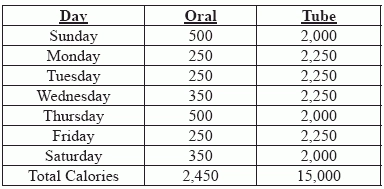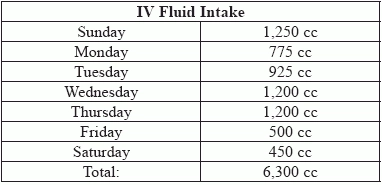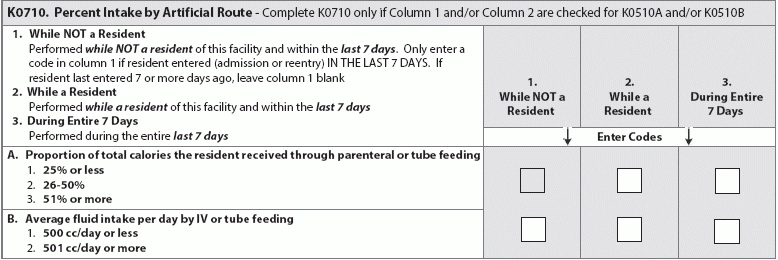Hone Your Math Skills To Perfect Your K0710 Coding
How to calculate fluid intake when resident had tube only one day. If you’re not following specific calculation conventions, you could be coding item K0710 — Percent Intake by Artificial Route all wrong. Keep these rules in mind when tackling this item to ensure that you’re recording intake accurately. Important: You need to code item K0710 only if either parenteral/IV feeding or enteral feeding is coded, says Megan Finnie, RDn, CsG, LD, Chief Operations Officer for Dietary Consultants, inc. Look for boxes checked for items K0510A — Parenteral/IV feeding and K0510B — Feeding tube – nasogastric or abdominal (PEG). Calculate the Percentages for Total Calories First, you must code K0710A — Proportion of total calories the resident received through parenteral or tube feeding. The coding choices are: You should review the resident’s intake records to figure out actual intake through parenteral or tube feeding routes, and then calculate the proportion of total calories received through these routes, according to the RAI Manual. If the resident took no food or fluids by mouth or only took sips of fluids, you should code 3 — 51% or more. But if the resident had a more substantial oral intake, you’ll need to consult with your facility’s dietitian. You’ll need to determine the correct coding by calculating the percentages from the dietitian’s measurements of oral versus tube feedings. Learn From This K0710A Scenario Example: Mr. Hayes had a feeding tube post-surgery and is eager to have it removed. He’s been taking soft solids orally in small to moderate amounts. For the past seven days, Mr. Hayes has been receiving tube feedings for nutritional supplementation. The dietitian’s notes on Mr. Hayes’ daily calorie intake are as follows: In this scenario, the total oral intake is 2,450 calories and the total tube intake is 15,000 calories, according to the RAI Manual. Added together, the total calories for the seven days is 17,450. To calculate the percentage of total calories by tube feeding, divide the total tube intake by the total calories, and then multiply the result by 100 (15,000/17,450 = .859 X 100 = 85.9%). This means that Mr. Hayes received 85.9 percent of his calories by tube feeding, so you would code K0710A as 3 — 51% or more. Study the Dietitian’s Notes to Code K0710B Then, you will need to code K0710B — Average fluid intake per day by IV or tube feeding. The coding choices are: To determine the correct coding for K0710B, you should first review the resident’s intake records for the last seven days. Add up the total amount of fluid received each day via IV and/or tube feedings only, and then divide the week’s total fluid intake by seven. This will give you the average fluid intake per day. Example: Mrs. Anderson has Huntington’s disease, which causes swallowing difficulties. She can take oral fluids by mouth with supervision, but not enough to maintain hydration. She requires supplemental tube feedings, including water, prepared nutritional supplements and juices. The dietitian recorded the following IV fluid intake during the last seven days: For this scenario, the total fluid intake by supplemental tube feedings is 6,300 cc, which you would divide by seven days to get a daily average of 900 cc (6,300/7 = 900), the RAI Manual states. Because 900 cc is greater than 500 cc, you would code Column 2 (While a Resident) and Column 3 (During Entire 7 Days) for K0710B as 2 — 501cc/day or more. Always Divide by 7 for Fluids But what if the resident didn’t receive IV or tube fluids every day during the look-back period? Further, what if the resident received supplemental fluid on only one day? Important: For calories and fluid, you always divide the number by seven, Finnie stresses. Even if parenteral/IV or enteral were not received for the entire seven-day Assessment Reference Date (ARD) look-back window, you still divide by seven. Another example: Mr. Miller received 1,000 cc of IV fluids in the hospital on the Tuesday prior to his admission to your facility on Saturday. He received no other intake via IV or tube feeding during the last seven days. Here, the total fluid intake by supplemental tube feedings is 1,000 cc, which you would divide by seven days to get the average fluid intake of 142.9 cc per day (1,000/7 = 142.9), according to the RAI Manual. Because 142.9 cc is less than 500 cc, you would code Column 1 (While NOT a Resident) for K0710B as 1 — 500cc/day or less.




